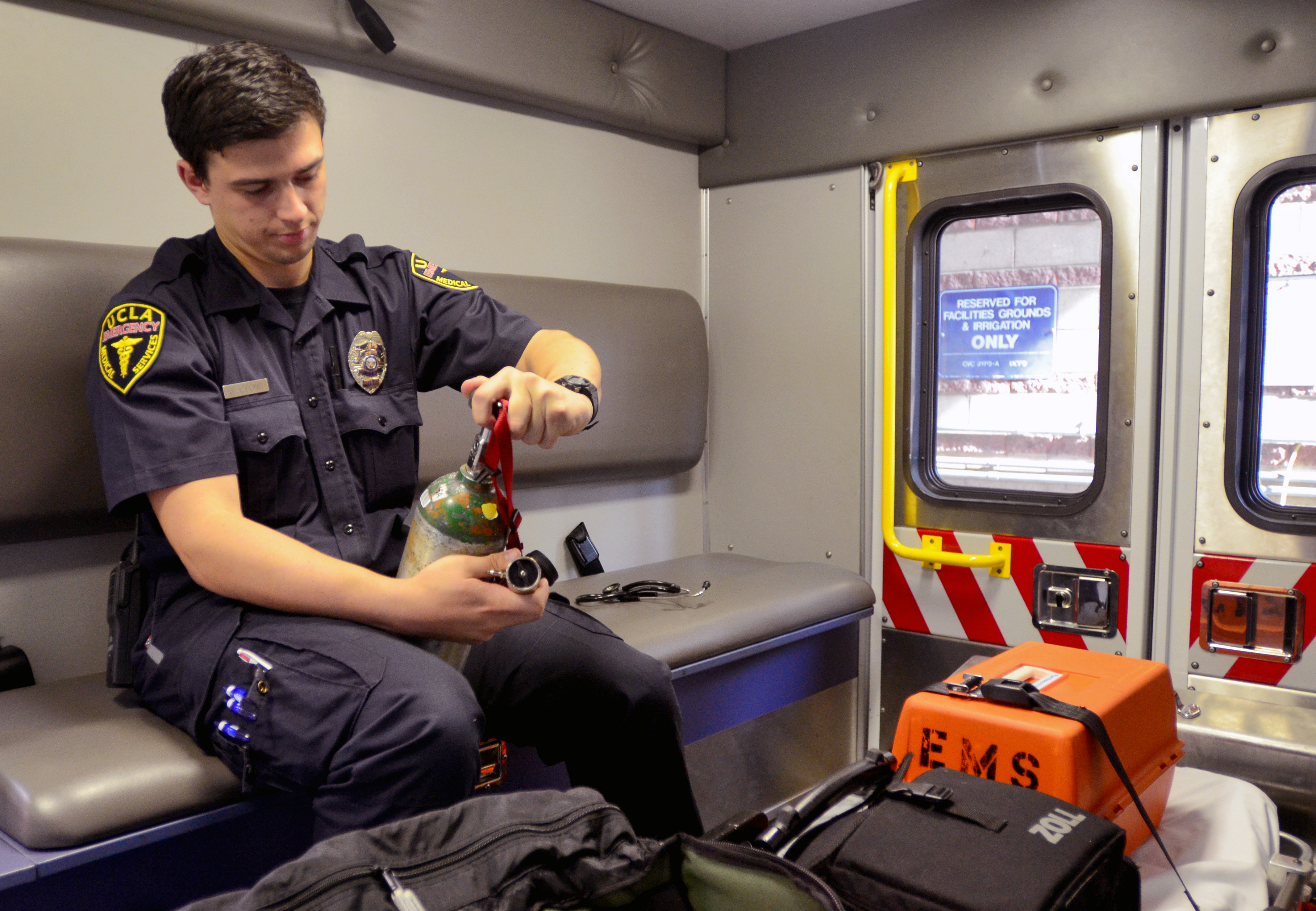
Third-year psychobiology student Jon Lyons, one of UCLA’s EMTs, checks through a first-aid kit in the ambulance before going on duty.

As EMTs, third-year student Jon Lyons (left) and alumnus Adam Khadivi provide ambulance coverage for the UCLA campus, from Hilgard to Veteran avenues and Wilshire to Sunset boulevards as well as the surrounding areas.

Jon Lyons, a third-year psychobiology student and EMT, goes through a rig check to make sure his ambulance’s equipment is ready for use.
Adam Khadivi and Paul Pelletier pull up to the 7-Eleven on Westwood Boulevard.
Jumping out of the driver’s seat, Khadivi leaves the ambulance running. Pelletier, shaking his head at his partner, leans across the passenger’s seat and turns the vehicle off.
“I just have a feeling we are going to get a call,” Khadivi says.
Two slurpies and zero emergency medical aid calls later, Khadivi, a 2010 UCLA alumnus, and Pelletier, a second-year physiological science student, resume their lazy Friday afternoon patrol around Westwood.
Driving down Sunset Boulevard with rock music playing, Khadivi and Pelletier await a call to come over the radio. A call that will require them to think quickly, alter their route and take action.
But that call doesn’t come ““ at least not for this shift.
Khadivi and Pelletier are among 23 students who work as emergency medical technicians for UCLA’s Emergency Medical Services.
Most students join as second- or third-years and can stay three to four years as long as they are students, Khadivi said. The program hires every fall and spring quarter.
UCLA’s EMTs respond to any basic life support calls, which include orthopedic injuries, nausea and pregnancy-related calls. They also provide ambulance coverage for the campus, from Hilgard to Veteran avenues and Wilshire to Sunset boulevards as well as surrounding areas, including the Veteran Affairs Hospital, Jackie Robinson Stadium and nearby locations if they are dispatched.
As students, the majority of the EMTs study pre-med or have aspirations of going into the medical field. Jon Lyons, a third-year psychobiology student and EMT, said the patient interaction he has during calls confirms his desire to go to medical school.
“A (basic life support) call on campus is just us responding from start to finish, making all the decisions,” he said.
Khadivi remembers getting a call about a 5-year-old going into cardiac arrest in the Medical Plaza. He said knowing his response saved a child is one of the reasons he wants to be a paramedic.
“I could see myself doing this for the rest of my life,” he said.
While waiting for the part of their shift when they can put their six months of training to use, the EMTs work the UCPD station front desk and file police reports.
“All yours,” Pelletier says to Khadivi as another person walks into the station to get fingerprinted.
For those who tend to work the day shift, like Khadivi and Lyons, waking up on time to get to the office by 7 a.m. has become second nature. In fact, both EMTs will normally exercise in the mornings before their shifts start.
“I have no problem waking up at 6 a.m. and being like “˜Sweet, I’m going to the ambulance today,'” Khadivi said.
On a Wednesday morning, Khadivi and Lyons walk around the police station before completing a required check of the ambulance.
Heading to the station’s garage, Khadivi knocks on the door of the EMT sleeping room. Filled with cots for EMTs to sleep in when working night shifts, he awakens a fellow student.
In the ambulance, Lyons rifles through a first-aid kit and checks the oxygen tank.
“By now we have both memorized what needs to be in here,” he says. “There are things we have to carry by law, others we have determined we need.”
After testing the lights and sirens, the EMTs decide to take a drive around Westwood. Khadivi said they commonly drive around on their shifts instead of staying at the station, as it only takes them three minutes to get from one side of campus to the other in case of an emergency.
In 2010, EMS received nearly 1,800 calls. Khadivi said the EMTs can go days without getting calls and then one day get 10 calls in eight hours.
Although the EMTs said the job is relaxing most of the time, it’s an adrenaline rush when they finally get a call.
The EMTs rely on their intensive training during medical aid calls.
Prior to applying to the EMS program, students must complete EMT classes, which Lyons completed in nine weeks during one quarter at UCLA.
The training after they are admitted includes weekly eight- to 12-hour emergency simulations and shifts.
Responding to a medical aid call for a scooter accident, Khadivi said he remembers the call running exactly like a simulation he had during training.
“We do (the simulations) so much that when we get a call, we know what to do,” Pelletier said. “We don’t have the experience of the (Los Angeles Fire Department) … but training has prepared us for everything.”
Behind the steering wheel of the ambulance, Khadivi said EMTs are required to get their ambulance driver’s license as well. The EMTs have to wait six months before they can drive the ambulance, which is wider than a normal street lane.
“It’s the only thing I have ever driven that is $200,000,” Khadivi said.
After spending the morning roaming Westwood streets, Khadivi and Lyons return to the station. Joking with a group of officers, Khadivi looks more like one of them than like a student.
Khadivi and Lyons resume their spot behind the police station front desk. Disappointed by the start to the day, the EMTs wait patiently for a call to come in.
“Welcome to the job,” Khadivi says, laughing.
